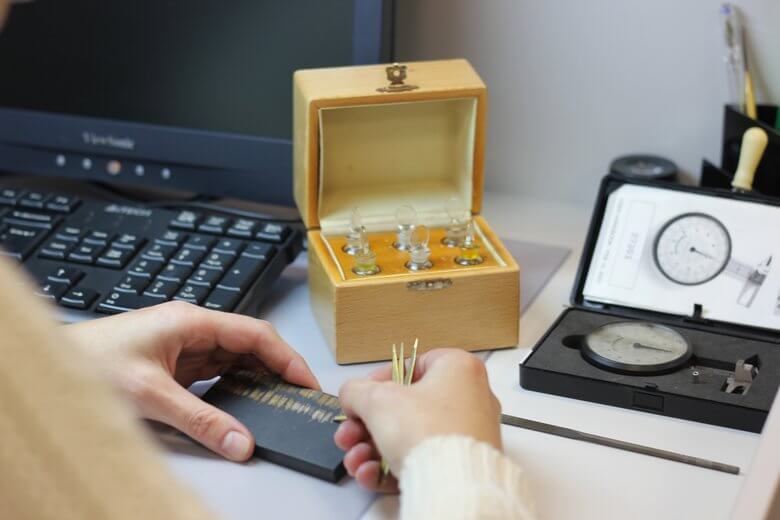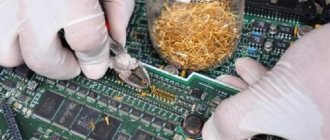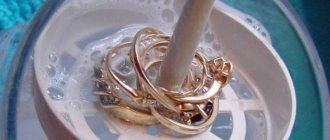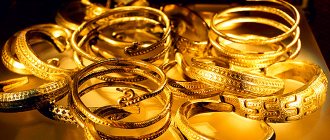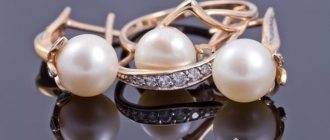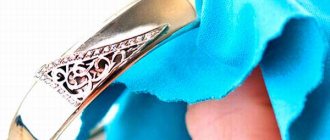Post updated: Oct 8, 2020
Platinum is a precious metal that is used to create jewelry. It became known back in the 18th century, but platinum has only now received a wide range of applications. Platinum is now used to make small jewelry such as rings, earrings and chains. Only small jewelry is popular because of its high final cost, which not everyone can afford. In the era of the Internet, it is very easy to buy jewelry, but there is one drawback - until you receive the item you cannot see and evaluate it, that is, you can easily buy a fake on the Internet. You can be safe from this by purchasing a platinum item in a special store, but even here you cannot be completely confident in the integrity of the sellers. The question arises - how to determine platinum, or rather its authenticity, and even at home?
Determine the weight and density of the decoration
Platinum is quite heavy and can only be compared with the metals of its group: iridium, osmium, uranium and rhenium. All other metals are much lighter. On top of that, when producing jewelry, the weight of platinum will be from 85% to 95% of the total mass. In other words, platinum jewelry is made almost entirely of base metal. And therefore, how to distinguish platinum from possibly similar other metals is a very important question.
For example, gold and silver products have less precious metal in their mass, which affects its cost and overall value. In such a mixture, it is not advisable to use iridium, osmium or rhenium for weighting, since they, in addition to the same price as platinum, are also rarely found in the natural environment. To understand whether the jewelry is made from real raw materials, you need to select a sample that needs checking and compare it with one of similar size. Such a ring will be much heavier than the opponent, but if the ring is the size of a grape, you will have to use precise scales to determine the platinum.
If you have a measuring cup or other vessel for measuring volume, you can use it to measure the density of the decoration. To do this, weigh the product and lower it into a vessel with water, after which we look at the volume of water squeezed out in cubic centimeters (should be about 21.45).
If approximately 21.45 cubic centimeters of water have been removed, then we can talk about the authenticity of the decoration.
A little about metal
Platinum is a metal characterized by high hardness and density, therefore in the jewelry industry it is used in almost pure form, while the gold alloy can contain up to 63% alloy. The following samples are typical for platinum:
- 850: the alloy consists of 85% precious metal and 15% alloy;
- 900: the alloy consists of 90% precious metal and 10% alloy;
- 950: the alloy consists of 95% precious metal and 5% alloy.
Metals such as rhodium, palladium, iridium and silicon are added to platinum as alloys. These metals do not add an uncharacteristic tint to platinum, but only emphasize its white-silver radiance.
Chemistry will help
Science can teach you how to determine platinum at home; there are many videos in which experienced jewelers teach this testing method. For example, you can use a product that is in every first aid kit - iodine. Its drop on a product made from original raw materials should be dark, this will be an indicator of authenticity. The darker the iodine, the higher the purity of the metal, and after wiping, there should be no streaks left on the product.
Ammonia is also a good way to test the precious metal. If platinum is exposed to it, then it will not react in any way to its influence, all other metals will turn black and this will be a good method to check the authenticity of jewelry.

It's unlikely, but you may have nitric and hydrochloric acid at your disposal at the same time. These chemical liquids must be mixed in a ratio of 1 to 3 to obtain the so-called “royal vodka”. When heated, the mixture will gradually dissolve the platinum, but when cold, nothing should happen.
Checking jewelry
You should check the authenticity of the metal in the store. Of course, platinum cannot be determined by eye, but there are still nuances that will help avoid counterfeiting. The main rule is to buy products in jewelry stores and salons who fear for their reputation.
In such places, sellers are not interested in selling counterfeit goods. Therefore, each ring or pendant undergoes a thorough check, during which the red limit for platinum is determined. Such a laboratory test instantly shows the authenticity of the metal. But, alas, it is impossible to repeat it at home.
When purchasing products, pay attention to their size. Platinum jewelry is almost never massive. This is due to the high price and rarity of the metal. Therefore, if you are offered large earrings or a bracelet, you should be wary - this is a fake.
Another way to determine the authenticity of platinum in a store is to hold the product in your hands for half a minute. If the metal remains cold upon touching the body, it means that this is real jewelry.
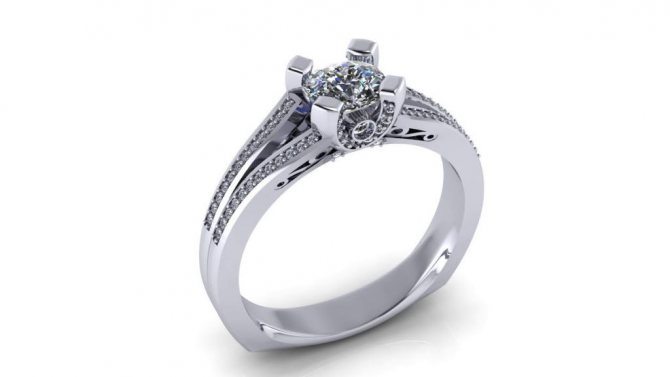
Distinguishable from silver
Silver has a much lower price than platinum, which is why unscrupulous manufacturers often pass off silver as a more expensive metal. To identify silver, look at the color of the item. The counterfeit metal is lighter, while silver has a certain gray tint. Also remember that large jewelry is not made from platinum due to its high cost, so if you are offered a large chain at a low price, then it is most likely a scam.
From left to right: silver, platinum and white gold.
You can test platinum at home “by the tooth”, platinum will withstand being bitten, and silver will receive a small mark from the tooth. Platinum is harder and therefore resistant to physical impact. At home, you can also take a rotten egg on which you can put both decorations. Silver will turn black due to hydrogen sulfide, but platinum will retain its fresh appearance as before, which will help determine the authenticity of the product.
How to distinguish from silver
Most often they try to pass off silver as platinum, so it is important to know their differences.
Color
Despite all the similarities between these noble metals, there are differences. Silver has a grayish tint, while platinum is lighter and shiny. Over time, silver tarnishes, platinum does not.
Weight and density
Platinum is almost twice as heavy and dense as silver. Even if you compare two pieces of jewelry that are approximately the same size, even without a scale, you will easily feel the difference. I told you how to determine density at the beginning of the article.
Resistance to mechanical stress
High density results in resistance to mechanical stress. Inspect the jewelry carefully: you are unlikely to find scratches or deformations on platinum. On silver everything is exactly the opposite.
Heat resistance
Platinum, unlike silver, is a refractory metal. At home it is impossible to create the necessary temperature for melting it. Even special jewelry furnaces for melting gold cannot cope with this task. Silver will darken where it is heated even from a lighter flame. This will not affect platinum: if you heat a platinum product for a few seconds, you will not get burned by touching the heating area.
Also watch the visual video below:
Heating
Platinum is very refractory, so it cannot be melted using a lighter flame. It will also not succumb to a gas stove or even a burner. This material does not change color when heated, since it is impossible to quickly change its temperature. That is why, when the platinum ring is briefly heated, you can put it on your finger without fear, because the jewelry inside will not have time to warm up. But based on this experiment, it is impossible to draw unambiguous conclusions, which means you must either use other verification methods or contact a specialist who knows exactly how to check the authenticity of the platinum product you purchased.
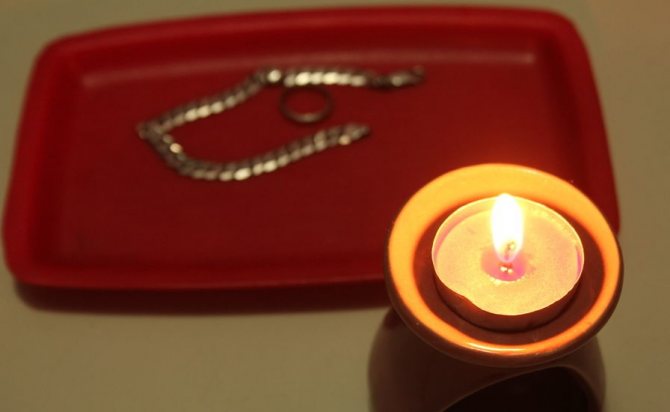
It is a specialist who will be able to help if you do not know how to test platinum. And only then can you be completely sure that you are wearing a real noble metal.
How to distinguish platinum from silver at home
There are several effective ways to determine whether you have platinum or silver. Almost all the necessary components are available at home.
Test using hydrogen peroxide. Pour enough solution into the container so that the liquid covers the jewelry completely. They look at the reaction. Platinum is a strong catalyst for peroxide and when interacting with the substance, a fizz will immediately appear. The liquid will not have such a reaction to silver. If a reaction occurs, it will be very weak.
Special acid solution for checking jewelry. A drop of the substance is applied to the surface of the metal. If you are absolutely sure that the alloy is too brittle, then you cannot use acid, it will immediately corrode it. The liquid will change color after interacting with the silver alloy. For example, if it darkens or turns bright red, the metal contains at least 99% silver. If it turns white, it means the jewelry contains 92.5% precious metal. If the drop turns bluish-green, the jewelry is made of copper or another less valuable metal.
A simple and effective way to test platinum and silver is with an ammonia solution. It is based on the fact that when liquid comes into contact with metals, it leaves dark marks on them. On platinum, no changes will occur.
Of course, these are not all the ways to distinguish platinum from silver. There is also aqua regia, a strong solution of table salt, a magnet and much more. But it is better to use the services of specialists and take the jewelry for inspection.
Properties of platinum
Before you begin to define platinum, you need to know how it differs from other decent metals. First you need to estimate the weight. Looking at the location of platinum in the periodic table, we can see that it is one of the heaviest metals; only osmium and iridium have a higher density. For jewelry work, platinum of at least 850 standard is used, which means that the product contains at least 85% pure precious metal. Considering that the standard of products made from silver or gold is usually lower, consequently there are fewer of these metals themselves in the product. No household chemicals affect platinum, which means that traces of iodine or acetic acid will not remain on the product. Neither water nor air oxidize this metal; it is one of the most chemically inert elements. Liquid bromine and “regia vodka” (a mixture of 2 concentrated acids, hydrochloric and nitric), are capable of dissolving platinum. But this is a very slow process. Ordinary household burners are not able to melt metal because it melts at temperatures above 1768 degrees.
How to check the authenticity of platinum at home
Platinum has a pure white luster that is unlike any other metal. Silver of even the highest standard will have a grayish tint.
Do you think it is necessary to distinguish platinum yourself? Here are several ways to test platinum.
Ammonia or ammonia
Ammonia is easy to obtain at any pharmacy. Ammonia will not react with metal, unlike others that leave dark stains. If no reaction occurs, you are the happy owner of a real jewel.
Iodine
Contact with iodine will cause a dark spot to appear on the platinum. It can be easily removed immediately after the experiment. The darker the color of the spot, the higher the grade of the metal.
Salt
Salt will also come to the rescue if you need to check the authenticity of the jewelry. This experiment will require a little work. You will need:
- can;
- batteries;
- salt and water solution.
Pour the solution into a jar and place the decoration in it. The plus batteries must be connected to the product, and the minus batteries must be connected to the jar. If sediment forms and the liquid becomes cloudy, you are dealing with a fake. If the water remains clear, everything is fine. If you smell chlorine, don't be alarmed. This is the result of the reaction. You have the original in your hands.
Magnet
This method is the least effective, but also has a right to life. Like other noble metals, platinum is not attracted to magnets. This will protect you from crude counterfeiting, but it will not be possible to distinguish silver from platinum in this way.
